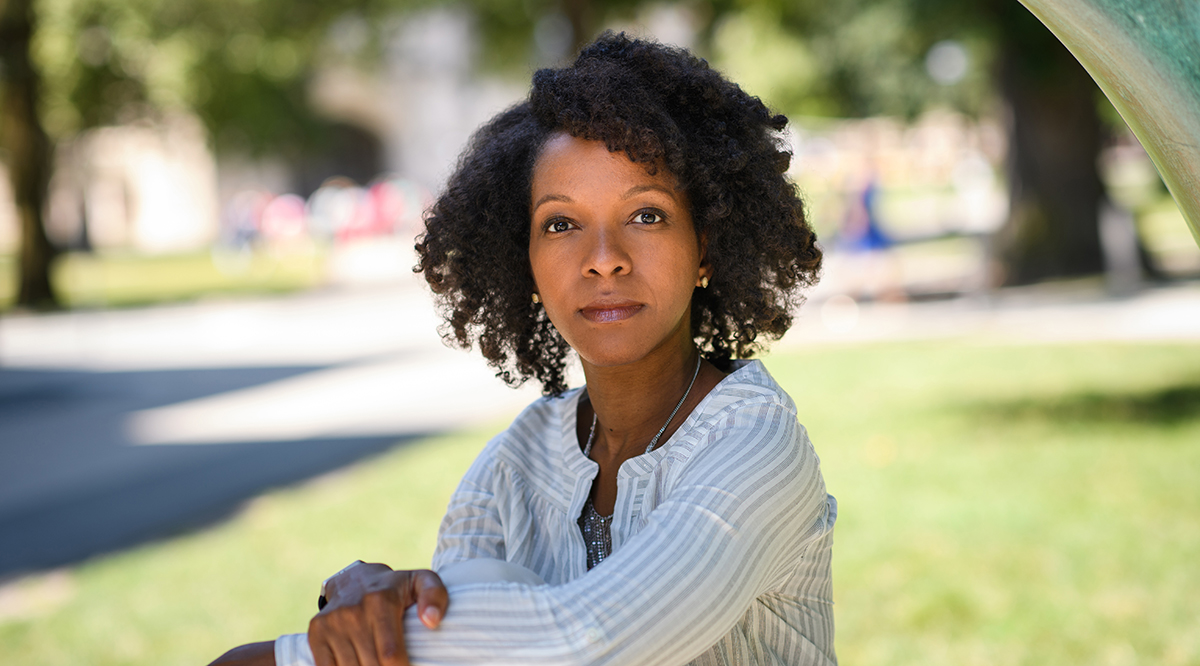 Credit: Sameer Khan
Credit: Sameer Khan
As an Alabama-born Black woman raised in the Northeast, Imani Perry, JD, PhD, had heard her share of digs at the South’s “backwardness.” Many Americans, she observed, had a tendency to relegate the nation’s legacy of slavery, racism, and inequality to the region below the Mason-Dixon Line. They condemned the idolization of Confederate leaders but celebrated the slaveholders who helped found the United States. This characterization of the South as a separate, out-of-step stain on the nation struck Perry not only as inaccurately absolving the rest of the country from its own racism, but as an undeserved slight on the complexity of the South’s legacy and culture.
In her latest book, “South to America: A Journey Below the Mason-Dixon to Understand the Soul of a Nation,” Perry, who is a professor of African American Studies at Princeton University, explores the South and how it has shaped the United States — for worse and for better.
She will discuss her insights with Pulitzer Prize-winning biographer Jon Meacham at the closing plenary at Learn Serve Lead 2022: The AAMC Annual Meeting, in a session titled “Facing the Truth that the South Defines America: A Conversation with Imani Perry,” on Nov. 15.
Perry spoke with AAMCNews about her book and why the South’s legacy is relevant to health care today.
Q: What inspired you to write this book and in what ways does the South represent the “soul of America”?
I was born in Birmingham, Alabama, and I grew up in Massachusetts. So, I have spent my life departing and returning to the South and having this feeling that there’s this extraordinary mischaracterization of the region as somehow out-of-step and behind the rest of the country — this sort of other, strange place. That perception is a way to make the South the scapegoat for the nation’s sins or vulnerabilities, when in fact, a much better account is that the South is really where the country began, and the place where we are forced, I think, to confront in the most dramatic ways the tensions between the promises and the ideals of the nation and the reality of a history of cruelty and exploitation.
So, for the book, I wanted to correct that mischaracterization, but also delve into the South with a view toward the possibility of making our country think about how [we can live up to our professed ideals of equality for all, and how we can] attend to those who are most vulnerable in the fabric of the nation. The South is a place where there’s a lot of concentrated vulnerability, but also a place of some of the most extraordinary culture and imaginings [and dreams of freedom]. The book is a combination of an argument about our national identity and also a love letter to the region.
Q: In your book, you describe ways that people in the United States often relegate the South to “the country’s gully.” Why is this a common sentiment and how is it, as you say, a “convenient misunderstanding”?
There’s deep shame about the reality of how central slavery was to actually building the country’s prosperity and, of course, that becomes concentrated in the South because of the climate. Slavery was a national institution at first, but the core of slavery [took] place in the southern region, and then [the same region implemented racist Jim Crow laws. These were sources of shame for the United States on a global scale]. And so, to say, “Well, that’s just what happened down there,” becomes a way of trying to divorce that reality from the truth, which is that so much of how the United States became a global power is connected to that history.
One of the great challenges for Americans in terms of developing a kind of political maturity is to begin to step away from mythologies and romantic stories of the nation and confront honestly how we became what we are, for better and worse. I understand the impulse, because people want to separate themselves from the issue, but in fact to do so is actually to not see oneself — that is, to reject the mirror of the country altogether.
Q: In what ways do health care, and particularly health care education, play into the themes you explore in your book?
I come from a family of health care providers. My grandmother was a respiratory therapy assistant, my late father was a public health researcher. So, my family is filled with people who have worked in hospitals, and so many of the stories that surrounded my life are actually about people at moments of physical vulnerability, but also about inequality in health care. It is a topic that is near and dear to my heart. But it’s also one of the most dramatic areas in which we talk about inequality in all different kinds of ways. We talk about it in terms of income; we talk about it in terms of education; we talk about it in terms of the protection of rights — but nothing is as fundamental as your life. These moments of physical vulnerability are, in some ways, the most dramatic moments of the human life. I also am someone who lives with multiple chronic diseases. And so, for me, this work of health care and health education is an area in which stories are so incredibly important, because through stories, we actually understand people’s lives in a deeper way. The ability to empathize and the ability to listen carefully, I think, are incredibly important for physicians. I hope that there's a way in which what I have to share bears on their practice or is useful in some way. And I certainly, I’m honored to speak to people who do, I think, what is some of the most important work in the world.
Q: What do you think people at medical schools and teaching hospitals can take away from your research to help them confront racism at their own institutions?
Most important is [the lesson] to listen carefully. I know that so many physicians are under pressure to move quickly, to assess scientifically, but I think medicine is as much art as it is science. And art is dependent on attentiveness — pushing aside this shorthand set of assumptions, stereotypes, [and] judgments based upon the cadence of someone’s voice, or their appearance. And this is so much of what I’m talking about in the book. I think it’s relevant for the practice of medicine to try to really be attentive to people at a human level. I hope that message comes through. And I know that most — if not all — of the attendees already know this, but just to echo the point that such a crucial part of what they do is just to pay attention carefully — [to] listen.
